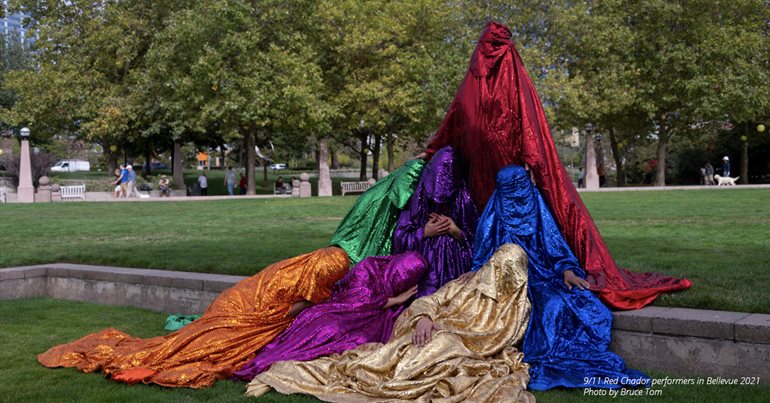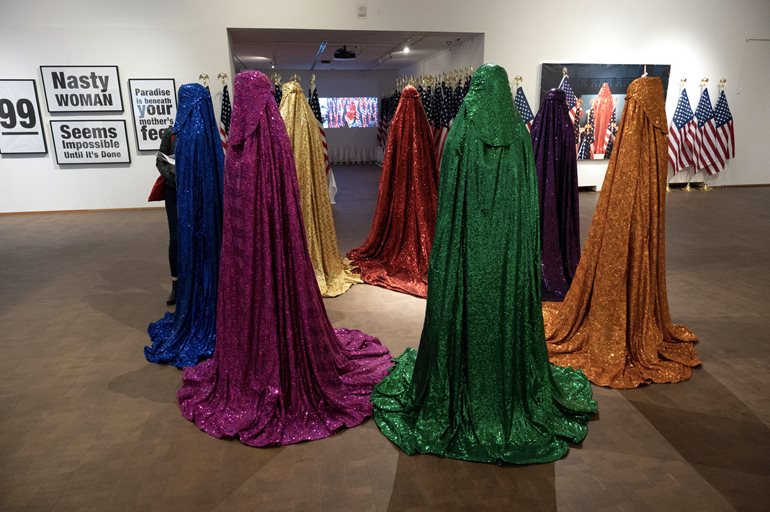A chador is a full-body gown worn by some Muslim women, but the Red Chador, created by Anida Yoeu Ali, is more than just a garment. It is an artistic expression that depicts to the public what it means to be a Muslim, a woman and a performer in an age of heightened Islamophobia.

Ali, a performance artist and senior artist-in-residence at the University of Washington Bothell, embodies the Red Chador, performing in communal spaces from bus stops and public parks to art fairs and renowned art institutions.
“Once I put on the garment, I lose my individual identity and become the representation of what people fear when they look at a veiled, Muslim body,” Ali said.
She explained that despite the garment being “sparkly, bright and gorgeous,” it often elicits fear in those who see it. “People have trembled when they’ve seen me as the Red Chador; they’ve run away, or they’d get angry,” Ali said. “My project is asking them to consider what it is they fear.”
Sparkly, red resistance
The Red Chador was originally commissioned to be performed in 2015 at the Palais de Tokyo Museum in Paris. Earlier that year, there was a series of terrorist attacks there that triggered a surge of Islamophobia and an increase in hate crimes against the Muslim community.
Ali wanted to engage in the political moment and create a response to the French government, which was then moving to ban burkas and all representations of Muslim identities in schools. “I knew I wanted to perform in Paris and be fully covered,” she said, “but I wanted to do it in a fun way.”
In creating the Red Chador, she designed it to be something that “a pious Muslim woman could wear to her prom.” She landed on the color after drawing inspiration from the pageantry of Catholicism, noting that the bishops, the authority figures of the church, often wear red. This was complemented by her love of science fiction films, noting the Star War imperial guards wear red, too.
The garment quickly gained prominence in the global art world for using the aesthetics of religion mixed with an element of humor to challenge social and political anxieties. After the initial performance in Paris, Ali performed as the Red Chador in four different countries: China, France, Scotland and Malaysia.
Her most moving performances, however, were closer to home in the United States.
Poignant performances
On November 9, 2016, the day after the presidential election, Ali embodied the Red Chador and walked the streets of Seattle holding a sign that read on one side, “I Am a Muslim,” and on the other, “Ban Me.” It was a response to Donald Trump’s proposed plan to ban all Muslim travel.
“The Red Chador let people walk with her, cry beside her and whisper secrets in her ear,” Ali said of the embodied chador. “A white, middle-aged woman embraced her that day and wrote her own sign on a scrappy manila folder. It read, ‘Not on my watch.’
“It’s these interactions that give the Red Chador’s performances their meaning,” she said.
Equally impactful was the 2016 Memorial Day weekend performance in Washington, D.C., hosted by the Smithsonian Institute’s Asian Pacific American Center. There, the Red Chador was surrounded by 99 American flags. Ali said a Marine approached a Smithsonian staffer and thanked her, saying, “I went out to fight for the country so that things like this could happen.”
The disappearance
The Red Chador’s final performance, unbeknownst to Ali at the time, was at the 2017 Kuala Lumpur Biennale. The costume went missing a month later and was last seen in Ben Gurion Airport in Tel Aviv, Israel.
Ali recalled being strip-searched by security at the airport prior to her flight to Tel Aviv, forced to check all her carry-on items, then detained for four hours by Israeli immigration officers. Eventually, she made it back to the U.S. only to realize the luggage with the Red Chador garment had not arrived — and never would.
“Immigration officers had my information and could easily have looked me up and seen the Red Chador. I can’t help but consider this a political act to try and silence me,” Ali said. “It was their way of announcing their disapproval of who I am and of what I do. They probably didn’t want me to ever return to the region.”
After four months of trying to find and bring home the Red Chador, Ali decided she must declare it “dead.” It was a devastating moment that forced her to think about loss and forced disappearances.
“I had to decide whether or not it was necessary for me to rebirth the Red Chador, to make another costume, re-embody her and go on as if I could just start again. That just didn’t feel right to me,” Ali said. “I needed to do something else that would make the work more profound than it was when it disappeared.”
The reemergence
That “something” ended up being a performance piece for the Bellwether Arts Festival in Bellevue, Washington, this past Sept. 11. “Whether it was serendipitous, divine intervention or just poetic, performing on the 20th anniversary of the 9/11 attacks was a critical and important moment for me and for the Red Chador,” she said.
Ali knew that in this reinvention she didn’t want to emerge alone, and she also knew she wanted to tackle more than just islamophobia. As an act of solidarity with the LGBTQ+ community, Ali created sequined chadors in red, orange, gold, green, blue, fuchsia and purple, creating a rainbow with six other people.
Before their performance of walking the streets of Bellevue, fully covered and veiled in sequined chadors, they took a moment to talk about what the day meant to each of them.
The conversation was incredibly moving, Ali said. “People were sharing such intense stories. One performer was a Japanese American and said she knew she had to do this performance because of what her ancestors went through during the Japanese American Internment. All she could think about was her grandfather saying, ‘This is what you need to do, you need to stand up so this never happens again,’” she said.
Reactions solidify purpose
“It is those stories that happened before the performance that, for me, got to the heart of what the piece is about — the gathering of a diverse group of people to stand in solidarity and support one another,” said Ali.
The 9/11 performance had some beautiful moments, but it had some awful moments, too.
One mother physically blocked Ali and the other performers from entering a public park. “She made a scene and was screaming saying she didn’t want any protests, that our presence was harming the kids and demanded that we leave,” Ali said. “Some parents looked at us with suspicion, grabbed their children and walked away in a fury.”
Then, when the performers entered Bellevue Square mall, Ali said there was an immediate increase in security. “We had every right to be there; we were silent and simply walking,” she said. “Yet our very presence instantly posed a threat.”
Art fuels life
Through these reactions, the Red Chador explores notions of political belonging and fear. Ali’s work is currently featured in a solo exhibition at the Western Gallery at Western Washington University titled, The Red Chador: Genesis I. The installation is open until Nov. 20, and on closing day Ali will feature a dance performance by UW Bothell students embodying the six chador garments and will be on hand to have conversations at a reception with the public.

It is the biggest solo exhibition of the work since the garment’s disappearance.
“A lot has happened since 2015 when I made the Red Chador to now,” Ali said. “The exhibit is extremely special because of the Red Chador’s presence at so many significant, political moments. As a result, the exhibit walks the viewer through a series of historical time stamps, and to me that’s the significance of the work.”
Ali is looking forward to continuing teaching students at UW Bothell and says that being an artist is the one job from which she will never retire.
“I wouldn’t know how to live without it,” she said.



